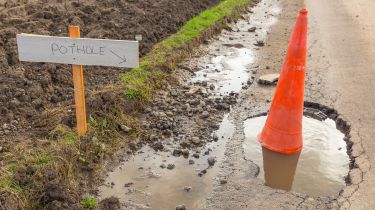Stop holding back pothole repair funding, councils tell the government
With National Pothole Day having arrived and a review of road maintenance spending around the corner, we look at the current situation on Britain’s roads

Local councils are calling on the government to “reconsider” holding back funding for pothole repairs because even the additional cash promised is, according to industry experts, “a fraction of what’s needed to prevent further decline”.
At the tail end of 2024, Chancellor Rachel Reeves doubled down on Labour’s election manifesto pledge to fill one million potholes per year by announcing £500 million in road maintenance funding for 2025 – as a supplement to the £1.1 billion already allocated after the cancellation of the controversial HS2 rail project.
However, sources on the ground say that a large chunk of this cash is still being held back, preventing necessary maintenance from being carried out. While the government has allocated funds to each corner of the country, it has kept back what it describes as ‘built-in incentives’ which will be bestowed upon councils that are deemed to be spending the cash effectively.
Councillor Adam Hug, the transport spokesperson from the Local Government Association, said: “The extra £500 million for local roads this year will help slow [road] deterioration, but we ask the government to reconsider its decision to hold back a quarter of this extra funding, in order to give councils the greater certainty they need.”
This money could be more necessary than ever because, according to data from the AA, the roadside assistance firm attended as many as 643,000 breakdowns caused by potholes in 2024 which, while fractionally less than in 2023, still puts the number of incidents at its highest point since 2018.
Furthermore, the RAC claims breakdowns caused by pothole damage were up by almost a fifth (17 per cent) in the final quarter of 2024, compared with the three months prior. Despite potholes becoming more common in the winter, RAC officials said that these statistics were “surprising [given that] there were fewer frost days than average in Q4, and rainfall was lower than average, too”. To add insult to injury, spokesperson Alice Simpson remarked that “sadly, we expect the upward trend to continue in 2025 as the snow and ice currently affecting much of the UK freezes and expands, causing cracks in the road.”
These statistics mark a bitter end to 2024 because, even with a rise in the amount of preventative maintenance over the year, such as surface redressing – essentially the application of a waterproof layer that prevents water from entering cracks in the road – pothole-related insurance claims were up by 14 per cent compared with the previous year, marking a two-year rise of 62 per cent.
Adam Gavin, head of claims at insurance firm Admiral, told Auto Express that “although pothole-related claims have increased by 14 per cent in the last year, any claim can impact a customer's premium, which is why we believe that the [figures] we see are just the tip of the iceberg. There will be many drivers who choose not to claim for minor damage whose experience is not showing up in our data.”
Yet even with Labour’s additional injection of cash, the road-building industry believes that the available funds are just a drop in the ocean compared with what is needed to solve the issue. Last year, the Asphalt Industry Alliance (AIA) estimated that over £16 billion would be required to fix the almost 250,000 miles of road in Great Britain, with more than half of roads in England and Wales estimated to have less than 15 years of structural life left.
The AIA’s chairman, David Giles, told Auto Express that “the solution goes far beyond filling potholes. We know from our survey that conditions are currently at an all-time low due to decades of underfunding. Unfortunately, though, the funds allocated to date fall short of the long-term funding horizon the sector has been calling for and are a fraction of what’s needed to prevent further decline.”
Giles called for what he described as “a multi-year ringfenced investment commitment [from the government]. This will help to ensure that highway engineers are able to take a holistic approach to maintaining the network, allowing them to use the right intervention at the right time.”
“A longer-term approach from [the] central government would also give the industry more confidence to invest further in lower-carbon solutions and equipment as well as in developing the skills of those that work across the sector,” he added.
This outcry was seconded by the LGA, with Councillor Hug stating that “Greater and sustainable long-term funding will enable councils to far more effectively plan for and invest in preventative treatments, which keep surfaces in better condition for longer.”
The Department for Transport is set to launch a spending review in the first quarter of this year. This will give us our first glimpse of the new government’s road maintenance strategy, with the current one set to end on 31 March.
Hug described this as “an opportunity to give councils greater, longer-term funding certainty, so they can help make our local roads more resilient to severe weather, boost inclusive economic growth and prevent potholes, which are more expensive to repair than preventative measures.”
Is the pothole situation getting worse in the UK? Let us know your thoughts in the comments section...
Find a car with the experts




